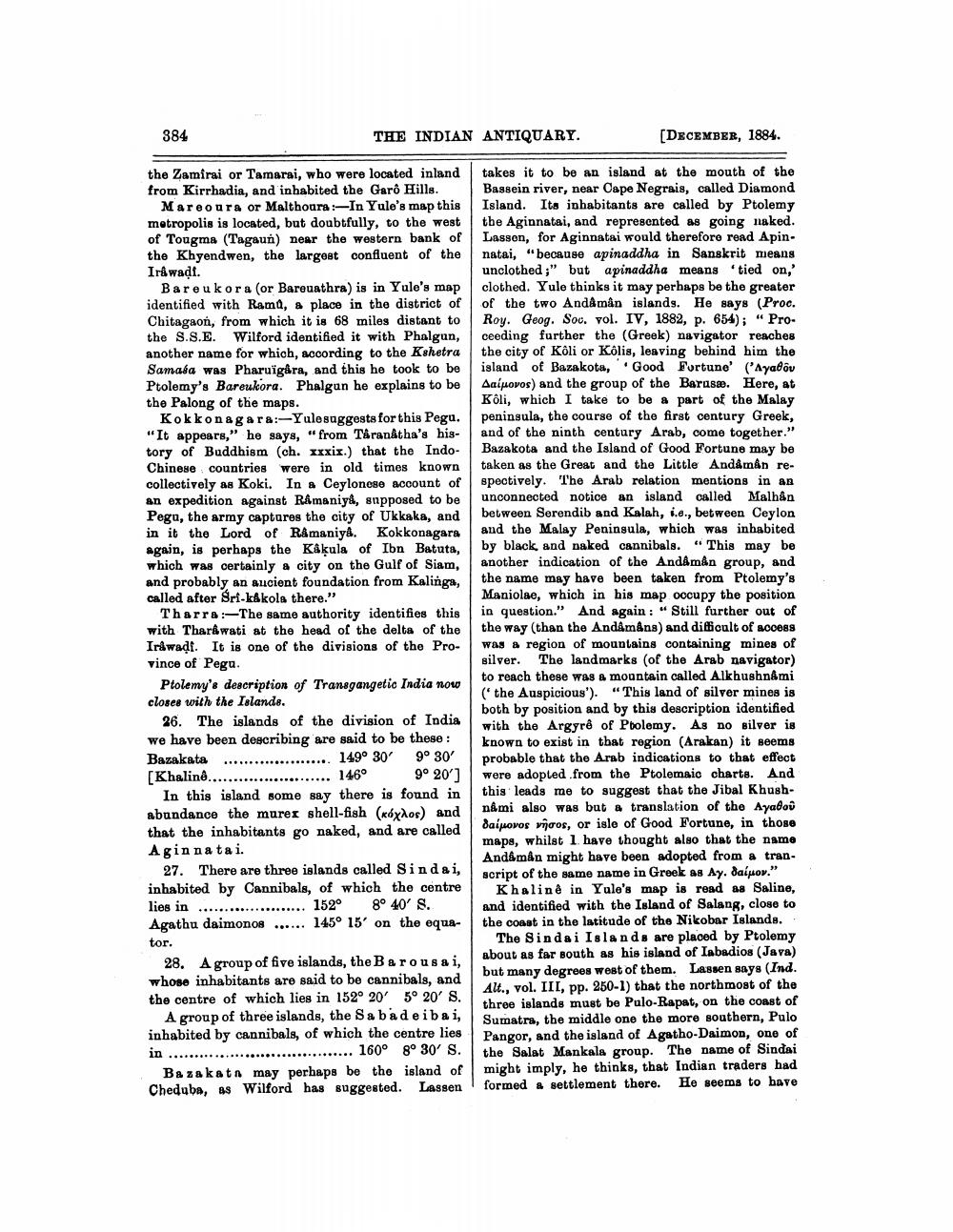________________
384
THE INDIAN ANTIQUARY.
[DECEMBER, 1884.
the Zamirai or Tamarai, who were located inland from Kirrhadia, and inhabited the Garo Hills.
Mareoura or Malthoura -In Yule's map this metropolis is located, but doubtfully, to the west of Tougma (Tagaun) near the western bank of the Khyendwen, the largest confluent of the Irwadi.
Bareu kora (or Bareuathra) is in Yule's map identified with Rama, & place in the district of Chitagaon, from which it is 68 miles distant to the S.S.E. Wilford identified it with Phalgun, another name for which, according to the Kshetra Samala was Pharuïgåra, and this he took to be Ptolemy's Barsukora. Phalgan he explains to be the Palong of the maps.
Kokkonagara:-Yulesaggests for this Pegu. "It appears," he says, "from Taranatha's bistory of Buddhism (ch. xxxix.) that the IndoChinese countries were in old times known collectively as Koki. In a Ceylonese account of an expedition against Råmaniye, supposed to be Pego, the army captures the city of Ukkaka, and in it the Lord of Råmaniya. Kokkonagara again, is perhaps the Kaķula of Ibn Batuta, which was certainly a city on the Gulf of Siam, and probably an aucient foundation from Kalinga, called after Sri-kakola there."
Tharra:-The same authority identifies this with Tharkwati at the head of the delta of the Irawadi. It is one of the divisions of the Province of Pegu.
Ptolemy's description of Transgangetic India now closes with the Islands.
26. The islands of the division of India we have been describing are said to be these Bazakata ..................... 149° 30' 9° 30' [Khalind........................ 146° 9° 20']
In this island some say there is found in abundance the murer shell-fish (kóxos) and that the inhabitants go naked, and are called Aginnatai.
27. There are three islands called Sindai, inhabited by Cannibals, of which the centre lies in ..................... 152° 8° 40' S. Agathu daimonos ...... 145° 15' on the equator.
28. A group of five islands, the Barousai, whose inhabitants are said to be cannibals, and the centre of which lies in 152° 20' 5° 20' S.
A group of three islands, the Sabad e ibai, inhabited by cannibals, of which the centre lies in ...................
.............. 160° 8° 30' S. Bazakat may perhaps be the island of Cheduba, as Wilford has suggested. Lassen
takes it to be an island at the mouth of the Bassein river, near Cape Negrais, called Diamond Island. Its inhabitants are called by Ptolemy the Aginnatai, and represented as going naked. Lassen, for Aginnatai would thereforo read Apinnatai, “because apinaddha in Sanskrit means unclothed;" but apinaddha means "tied on,' clothed. Yule thinks it may perhaps be the greater of the two AndAmân islands. He says (Proc. Roy. Geog. Soc. vol. IV, 1882, p. 654); " Proceeding further the (Greek) navigator reaches the city of Koli or Kôlis, leaving behind him the island of Bazakota, Good Fortuno' (Ayal ou Aaipovos) and the group of the Barasæ. Here, at Kôli, which I take to be a part of the Malay peninsula, the course of the first century Greek, and of the ninth century Arab, come together." Baza kota and the Island of Good Fortune may be taken as the Great and the Little Andaman respectively. The Arab relation mentions in an unconnected notice an island called Malhân between Sorendib and Kalah, i.e., between Ceylon and the Malay Peninsula, which was inhabited by black and naked cannibals." This may be another indication of the Andâmân group, and the name may have been taken from Ptolemy's Maniolae, which in his map oocupy the position in question." And again : "Still further out of the way (than the Andåmâns) and difficult of 200088 was a region of mountains containing mines of silver. The landmarks (of the Arab navigator) to reach these was a mountain called Alkhushnami (the Auspicious'). "This land of silver mines is both by position and by this description identified with the Argyrê of Poolemy. As no silver is known to exist in that region (Arakan) it seems probable that the Arab indications to that effect were adopted from the Ptolemaic charts. And this leads me to suggest that the Jibal Khushnâmi also was but a translation of the Ayalov daipovos voos, or isle of Good Fortune, in those maps, whilst 1 have thought also that the name And&man might have been adopted from a transcript of the same name in Greek as Ay. Dainor."
Khaline in Yule's map is read as Saline, and identified with the Island of Salang, close to the coast in the latitude of the Nikobar Islande..
The Sindai Islands are placed by Ptolemy about as far south as his island of Labadios (Java) but many degrees west of them. Lassen says (Ind. Alt., vol. III, pp. 250-1) that the northmost of the three islands must be Palo-Rapat, on the coast of Sumatra, the middle one the more southern, Pulo Pangor, and the island of Agatho-Daimon, one of the Salat Mankala group. The name of Sindai might imply, he thinks, that Indian traders had formed a settlement there. He seems to have




